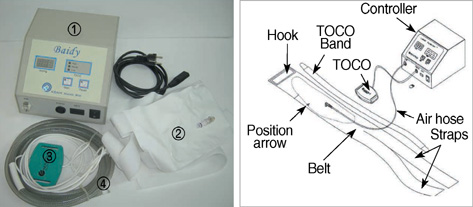J Korean Med Sci.
2009 Oct;24(5):951-955. 10.3346/jkms.2009.24.5.951.
The Efficacy and Safety of Inflatable Obstetric Belts for Management of the Second Stage of Labor
- Affiliations
-
- 1Department of Obstetrics and Gynecology, Pochon CHA University College of Medicine, Seoul, Korea. chadh001@hanmail.net
- 2Curexo Inc., R&D Center, Seoul, Korea.
- KMID: 1782021
- DOI: http://doi.org/10.3346/jkms.2009.24.5.951
Abstract
- This study was designed to assess the effect of inflatable obstetric belts on uterine fundal pressure in the management of the second stage of labor. One hundred twenty-three nulliparas with a singleton cephalic pregnancy at term were randomized. Standard care was performed in the control group, and uterine fundal pressure by the Labor Assister(TM) (Baidy M-420/Curexo, Inc., Seoul, Korea) was utilized in addition to standard care in the active group. The Labor Assister(TM) is an inflatable obstetric belts that synchronized to apply uniform fundal pressure during a uterine contraction. The 62 women in the active group spent less time in the second stage of labor when compared to the 61 women in the control group (41.55+/-30.39 min vs. 62.11+/-35.99 min). There was no significant difference in perinatal outcomes between the two groups. In conclusion, the uterine fundal pressure exerted by the Labor Assistertrade mark reduces the duration of the second stage of labor without attendant complications.
Keyword
MeSH Terms
Figure
Reference
-
1. Cunningham FG, Leveno KJ, Bloom SL, Gilstrap LC, Wenstrom KD. Parturition. Williams obstetrics. 2005. 22th ed. New York: McGraw-Hill;151–186.2. Merhi ZO, Awonuga AO. The role of uterine fundal pressure in the management of the second stage of labor: a reappraisal. Obstet Gynecol Surv. 2005. 60:599–603.
Article3. Kline-Kaye V, Miller-Slade D. The use of fundal pressure during the second stage of labour. J Obstet Gynecol Neonatal Nurs. 1990. 19:511–517.4. Zhao SF. Evaluation of an insufflatabe abdominal girdle in shorting the second stage of labor. Zhonghua Fu Chan Ke Za Zhi. 1991. 26:262–265. 3215. Cox J, Cotzias CS, Siakpere O, Osuagwu FI, Holmes EP, Paterson-Brown S. Does an inflatable obstetric belt facilitate spontaneous vaginal delivery in nulliparae with epidural analgesia? Br J Obstet Gynaecol. 1991. 106:1280–1286.
Article6. Buhimschi CS, Buhimschi IA, Malinow AM, Kopelman JN, Weiner CP. The effect of fundal pressure manoeuvre on intrauterine pressure in the second stage of labour. BJOG. 2002. 109:520–526.
Article7. Park Y, Roycroft PR, Song CH, Hahn S. The labor assister system™, automated system to facilitate normal vaginal delivery. Int J Assistive Robotics Mechatronics. 2006. 7:9–14.8. Thorp JA, Hu DH, Albin RM, McNitt J, Meyer BA, Cohen GR, Yeast JD. The effect of intrapartum epidural analgesia on nulliparous labour: a randomized, controlled, prospective trial. Am J Obstet Gynecol. 1993. 169:851–858.9. Newton ER, Schroeder BC, Knape KG, Bennet BL. Epidural analgesia and uterine function. Obstet Gynecol. 1995. 85:749–755.
Article10. Howell CJ. Epidural versus non-epidural analgesia for pain relief in labour. Cochrane Database Syst Rev. 2000. 2:CD000331.
Article11. Goodfellow CF, Hull M, Swaab D, Dogterom J, Buijs RM. Oxytocin deficiency at delivery with epidural analgesia. Br J Obstet Gynaecol. 1983. 90:214–219.
Article12. Bates R, Helm C, Duncan A, Edmonds DK. Uterine activity in the second stage of labour and the effect of epidural analgesia. Br J Obstet Gynaecol. 1985. 92:1246–1250.
Article13. Bahar AM. Risk factors and fetal outcomes in cases of shoulder dystocia compared with normal deliveries of a similar birthweight. Br J Obstet Gynaecol. 1996. 103:868–872.14. Cosner KR. Use of fundal pressure during second-stage labour. A pilot study. J Nurse Midwifery. 1996. 41:334–337.15. Pan HS, Huang LW, Hwang JL, Lee CY, Tsai YL, Cheng WC. Uterine rupture in an unscarred uterus after application of fundal pressure. A case report. J Reprod Med. 2002. 47:1044–1046.16. Lee WK, Baggish MS, Lashgari M. Acute inversion of the uterus. Obstet Gynecol. 1978. 51:144–147.17. Amiel-Tison C, Sureau C, Shnider SM. Cerebral handicap in full-term neonates related to the mechanical forces of labour. Baillieres Clin Obstet Gynaecol. 1988. 2:145–165.
- Full Text Links
- Actions
-
Cited
- CITED
-
- Close
- Share
- Similar articles
-
- A Comparison of Efficacy and Safety of Ritodrine hydrochloride alone and Combined Treatment with Magnesium sulfate in the Management of Preterm Labor
- Neuraxial analgesia: a review of its effects on the outcome and duration of labor
- Use of progesterone as a preventive medicine and nifedipine as a treatment of preterm labor
- Preterm Labor and Birth: Definition, Assessment, and Management
- A Comparison of Efficacy and Safety of Magnesium sulfate and Ritodrine Hydrochloride in the Management of Preterm Labor


